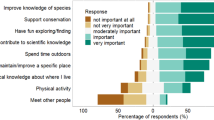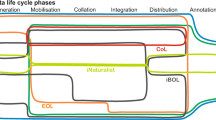Abstract
Biodiversity information is essential for understanding and managing the environment. However, identifying and providing the forms and types of biodiversity information most needed for research and decision-making is a significant challenge. While research needs and data gaps within particular topics or regions have received substantial attention, other information aspects such as data formats, sources, metadata, and information tools have received little. Focusing on the US southeast, a region of global biodiversity importance, this paper assesses the biodiversity information needs of environmental researchers, managers, and decision makers. Survey results of biodiversity information users’ information needs, information-seeking behaviors and preferred information source attributes support previous conclusions that useful biodiversity information must be easily and quickly accessible, available in forms that allow integration and visualization and appropriately matched to users’ needs. Survey results concerning additional information aspects suggest successful participation in both the creation and provision of biodiversity information include an increased focus on information search and other tools for data management, discovery, and description.



Similar content being viewed by others
References
Abell R, Olson DM, Dinerstein E, Hurley P, Diggs JT, Eichbaum W, Walters S, Wettengel W, Allnutt T, Louks CJ, Hedao P (2000) Freshwater ecoregions of North America: a conservation assessment. Island Press, Washington, DC
Balmford A, Crane P, Dobson A, Green RE, Mace GM (2005) The 2010 challenge: data availability, information needs and extraterrestrial insights. Philos Trans R Soc B 360(1454):221–228. doi:10.1098/rstb.2004.1599
Carlson J, Fosmire M, Miller CC, Nelson MS (2011) Determining data information literacy needs: a study of students and research faculty. Libr Acad 11(2):629–657. doi:10.1353/pla.2011.0022
Cullen P, Cottingham P, Doolan J (2001) Knowledge seeking strategies of natural resource professionals. In: Paper presented at the synthesis of a workshop held in Bungendore, NSW, 5–7 June 2000, Bungendore, NSW
Cushing J, Wilson T (2005) Eco-informatics for decision makers: advancing a research agenda. In: Paper presented at the workshop on eco-informatics for resource management decision makers, Olympia, Washington, 13–15 December 2004
Fong BL, Hansen DB (2012) Engaging research groups: rethinking information literacy for graduate students. Issues Sci Technol Librariansh Fall(71). doi:10.5062/F4V122Q6
Garvey WD (1979) Communication, the essence of science: facilitating information exchange among librarians, scientists, engineers, and students. Pergamon Press, Oxford
Garvey WD, Griffith BC (1972) Communication and information processing within scientific disciplines: empirical findings for psychology. Inf Storage Retr 8:123–126
Garvey WD, Lin N, Nelson CE (1970) Communication in the physical and the social sciences. Science 170(3963):1166–1173. doi:10.2307/1730630
Groombridge B, Jenkins M (1998) Freshwater Biodiversity: a preliminary global assessment. World Conservation Monitoring Centre, Cambridge
Heidorn PB (2001) A tool for multipurpose use of online flora and fauna: the biological information browsing environment (BIBE). First Monday 6(2–5)
Hernandez RR, Mayernik MS, Murphy-Mariscal ML, Allen MF (2012) Advanced technologies and data management practices in environmental science: lessons from academia. Bioscience 62(12):1067–1076
Hunt K, Kahl JS, Rubin J, Mageean DM (2007) Assessing the science-based information needs of stakeholders: a case study on acid rain research and policy. J Contemp Water Res Educ 136:68–79
Jacobs K, Garfin G, Lenart M (2005) More than just talk: connecting science and decisionmaking. Environ Sci Policy Sustain Dev 47(9):6–21
Janse G (2006) Information search behaviour of European forest policy decision-makers. For Policy Econ 8(6):579–592
Jones SA (2010) Southeast regional assessment project. United States Department of the Interior, United States Geological Survey. http://serap.er.usgs.gov. Accessed 22 Nov 2013
Kagan JS (2006) Biodiversity Informatics: challenges and opportunities for applying biodiversity information to management and conservation. Northwest Nat 87(1):80–85
Kirkman LK, Golladay SW, Laclaire L, Sutter R (1999) Biodiversity in southeastern, seasonally ponded, isolated wetlands: management and policy perspectives for research and conservation. J N Am Benthol Soc 18(4):553–562
Kopytko N, Cushing JB, Zeman L, Stevenson-Molnar N, Martin F, Keeley ES (2009) Making ecology research results useful for resource management: a case study in visual analytics. In: Paper presented at the proceedings of the 10th annual international conference on digital government research: social networks: making connections between citizens, data and government
Laihonen P, Ronka M, Tolvanen H, Kalliola R (2003) Geospatially structured biodiversity information as a component of a regional biodiversity clearing house. Biodivers Conserv 12:103–120
Laihonen P, Kalliola R, Salo J (2004) The biodiversity information clearing-house mechanism (CHM) as a global effort. Environ Sci Policy 7:99–108
MacDonell M, Morgan K, Newland L (2002) Integrating information for better environmental decisions. Environ Sci Pollut Res 9(6):359–368. doi:10.1007/bf02987582
Magness DR, Morton JM, Hutton J (2010) How spatial information contributes to the conservation and management of biodiversity. In: Cushman S, Huettman F (eds) Spatial complexity, informatics and wildlife conservation. Springer, Berlin, pp 429–444
McNie EC (2007) Reconciling the supply of scientific information with user demands: an analysis of the problem and review of the literature. Environ Sci Policy 10:17–38
Miller JR, Groom M, Hess GR, Steelman T, Stokes DL, Thompson J, Bowman T, Fricke L, King B, Marquardt R (2009) Biodiversity conservation in local planning. Conserv Biol 23(1):53–63
Mutshewa A (2007) The information behaviors of environmental planners: an exploratory study. Gov Inf Q 24(2):429–442
Pullin AS, Knight TM, Stone DA, Charman K (2004) Do conservation managers use scientific evidence to support their decision-making? Biol Conserv 119(2):245–252
Rogers C, McCarty JP (2000) Climate change and ecosystems of the Mid-Atlantic Region. Clim Res 14:235–244
Schiller A, Hunsaker CT, Kane MA (2001) Communicating ecological indicators to decision makers and the public. Conserv Ecol 5(1):19
Smith RK, Freeman PL, Higgins JV, Wheaton KS, FitzHugh TW, Ernstrom KJ, Das AA (2002) Priority areas of freshwater conservation action: a biodiversity assessment of the southeastern United States. The Nature Conservancy, Arlington
Smythe KD, Bernabo JC, Carter TB (1996) Focusing biodiversity research on the needs of decision makers. Environ Manag 20(6):865–872
Stein BA, Kutner LS, Adams JS (eds) (2000) Precious heritage: the status of biodiversity in the United States. Oxford University Press, New York
Szaro RC, Berc J, Cameron S, Cordle S, Crosby M, Martin L, Norton D, O’Malley R, Ruark G (1998) The ecosystem approach: science and information management issues, gaps and needs. Landsc Urban Plan 40(1–3):89–101
Tenopir C, Allard S, Davis M (2011a) Understanding the data management needs and data sharing challenges of environmental scientists. In: Paper presented at the environmental information management conference, Santa Barbara, CA, 28–29 September
Tenopir C, Allard S, Douglass K, Aydinoglu AU, Wu L, Read E, Manoff M, Frame M (2011b) Data sharing by scientists: practices and perceptions. PLoS ONE 6(6):e21101
Theobald DM, Hobbs NT, Bearly T, Zack JA, Shenk T, Riebsame WE (2000) Incorporating biological information in local land-use decision making: designing a system for conservation planning. Landsc Ecol 15(1):35–45
Theobald DM, Spies T, Kline J, Maxwell B, Hobbs NT, Dale VH (2005) Ecological support for rural land-use planning. Ecol Appl 15(6):1906–1914. doi:10.1890/03-5331
Tribbia J, Moser SC (2008) More than information: what coastal managers need to plan for climate change. Environ Sci Policy 11(4):315–328
U.S. Geological Survey (2011a) About USGS. Department of Interior. http://www.usgs.gov/aboutusgs/. Accessed 14 June 2011
U.S. Geological Survey (2011b) Core science systems. US Department of Interior. http://www.usgs.gov/core_science_systems/. Accessed 21 June 2011
Vaughan HH, Waide RB, Maass JM, Ezcurra E (2007) Developing and delivering scientific information in response to emerging needs. Front Ecol Environ 5(4):w8–w11
Acknowledgments
Many people were involved at various stages in this research and manuscript. Thanks to Beth Meko for her assistance on the literature review, Christopher Caldwell for his work on survey design, and Jana Redmond, Harrison Pang, and Ashley Pruitt for their work on the survey frame. Special thanks to Jean Freeney of US Geological Survey (USGS) for her support throughout the project. This project is based upon work previously supported by the USGS National Biological Information Infrastructure (NBII) Program before its program termination in 2012.
Ethics
The research in this study complies with all laws in the US. The study was approved by the University of Tennessee Institutional Review Board.
Conflicts of interest
The authors declare that they have no conflict of interest.
Author information
Authors and Affiliations
Corresponding author
Rights and permissions
About this article
Cite this article
Davis, M.L.E.S., Tenopir, C., Allard, S. et al. Facilitating Access to Biodiversity Information: A Survey of Users’ Needs and Practices. Environmental Management 53, 690–701 (2014). https://doi.org/10.1007/s00267-014-0229-7
Received:
Accepted:
Published:
Issue Date:
DOI: https://doi.org/10.1007/s00267-014-0229-7




